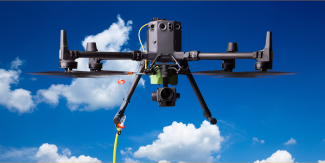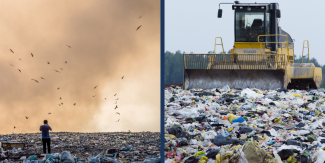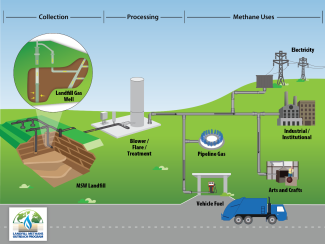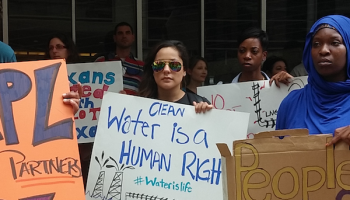Michigan’s landfills play a largely invisible role in the state’s climate crisis. While smokestacks and car tailpipes are widely recognized sources of greenhouse gas emissions, buried waste in landfills quietly fuels one of the most potent contributors to global warming: methane. When organic materials, such as food scraps, yard waste, and paper, decompose in oxygen-starved landfill conditions, they release methane, a greenhouse gas more than 80 times more effective than carbon dioxide at trapping heat over a 20-year period.
Despite recent updates to Michigan’s solid waste law that require landfills to monitor and address methane leaks, the economics of waste disposal still favor landfills as the cheapest and easiest option. Private landfill operators, who control the vast majority of Michigan’s waste infrastructure, have little financial incentive to shift away from disposal-focused business models. As a result, methane continues to seep into the air, driving climate change even as Michigan works toward emissions reduction goals.
To meaningfully tackle landfill methane, Michigan must move beyond small fixes and toward systemic change. Stronger public-private partnerships, expanded composting infrastructure, and enforceable methane controls could shift the balance toward sustainable waste management. Without these changes, landfills will remain hidden contributors to climate pollution — slowly but relentlessly warming the planet beneath our feet.
Preventing Landfill Methane Pollution in Michigan
“[Michigan is] the sixth-largest producer of landfill methane emissions, even though we’re only the 10th or 11th most populous state,” said Mike Garfield, executive director of the Ecology Center. “The basic reason is simple: We’ve made it too easy and too cheap to landfill waste.
Michigan should adopt enforceable best practices across the board — including tighter flare controls, real-time monitoring, and mandatory adoption of tools like Sniffer Robotics, an Ann Arbor-based company, who developed the only EPA-approved drone for landfill methane detection. Sniffer’s technology is already in use at Arbor Hills Landfill in Washtenaw County and can locate leaks faster and more accurately than older methods.

Why It Matters
Michigan has the highest trash per capita in the country, and the state’s landfills are the largest point source of industrial methane — a powerful greenhouse gas that traps 80 times more heat than carbon dioxide in the short term. In 2022, Michigan landfills emitted an estimated 17 million metric tons of CO₂ equivalent. This methane is generated as organic waste, like food scraps and yard trimmings, breaks down in landfills and escapes to the surface.

But methane isn’t the only concern. Landfill gas also contributes to ground-level ozone formation and contains toxic air pollutants that can harm nearby communities — many of which are made up of people who are BIPOC, low-income, or have chronic health conditions above the state average.
Utilities Claiming Landfill Gas as Clean Energy - EGLE Needs to Act to Fulfill Statute
Michigan’s clean energy law (Public Act 235, 2023) allows landfill gas to count as renewable energy — but only if landfills follow the best practices for gas collection and emissions monitoring, as defined by the Department of Environment, Great Lakes, and Energy (EGLE). This is an important safeguard. Without strong methane controls, landfills with energy projects can pollute unchecked emissions. Currently, rate-regulated utilities that file with the Michigan Public Service Commission are projecting that they will obtain approximately 286,000 renewable energy credits per year, for the near future, from landfill gas generation.
Given that Michigan's landfill emissions rank among the highest in the nation, inspections have uncovered troubling practices, and super-emitter methane plumes are being detected over Michigan landfills, mandatory best practices are urgently needed to advance our state’s climate mitigation efforts, slow warming, protect communities, and maintain the integrity of our clean energy law.
What Other States Are Doing
- Colorado has proposed landfill rules requiring remote monitoring, early gas collection, high-efficiency destruction devices, and better landfill covers. The estimated benefit-to-cost ratio of its draft rule is 6:1.
- California ties landfill gas eligibility in its biomethane procurement target to advanced emissions control and monitoring.
What EGLE Should Do to Protect Communities and Fulfill Statute
To protect communities and the integrity of Michigan’s clean energy standard, EGLE should require the following best practices at landfills claiming the renewable energy credit:
1. Better Gas Collection
Require automated wellhead tuning systems that continuously monitor pressure and gas quality to reduce methane leaks in real time. These systems are already in use at 140+ North American landfills, can improve gas capture by 10–30% and are required under California’s biomethane procurement target. In 2021, the Michigan legislature instituted several requirements, including requiring earlier installation of gas collection systems before waste is added and real-time expansion of the gas collection system as new waste is placed. These requirements help close loopholes, but automated wellhead tuning is needed to ensure these systems function effectively once installed.

2. Stronger Pollution Controls
Following other leading states like Maryland and Washington, ensure all flares and treatment systems are enclosed and destroy at least 99% of methane. Require regular performance testing and monitoring of flow rates to track effectiveness.
3. Better Landfill Covers
Limit the size of active dumping areas and require timely cover installation to reduce emissions. For long-term unused areas, require methane-oxidizing biocovers to naturally destroy methane in the soil.
4. Modern Methane Monitoring
Adopt satellite, drone, and continuous monitoring technologies to monitor more of the landfill more often. These tools are cheaper, safer, and more effective than old-fashioned walking surveys. They can survey the entire landfill — including areas currently ignored — and help guide repairs. Sources of “clean energy” should not be major methane polluters.
5. Public Transparency
Require landfills provide public, accessible reporting of all monitoring data and corrective actions so communities know what’s happening at nearby landfills.


